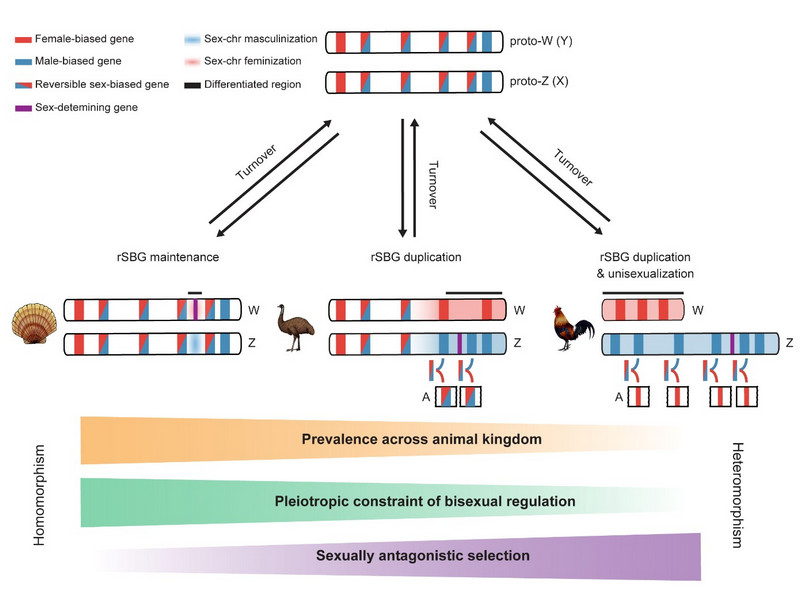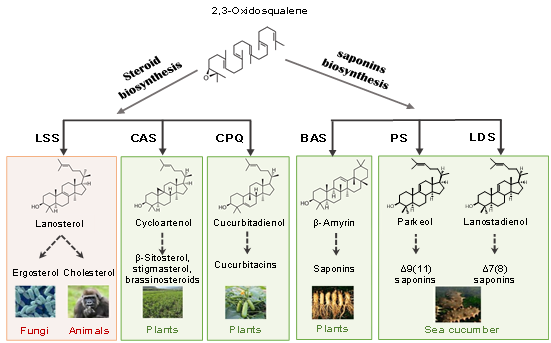
Our group published two important discoveries in Nature Ecol Evol and Nature Chem Biol
Recently, our research group has made progress in the evolution of homomorphic chromosomes in molluscan and the mechanism of saponin synthesis in sea cucumber. The research results were published in Nature Ecology & Evolution (Ancient homomorphy of molluscan sex chromosomes sustained by reversible sex-biased genes and sex determiner translocation), and Nature Chemical Biology (Biosynthesis of saponin defensive compounds in sea cucumber). Those studies follows our work on genome and transcriptome analysis of scallops and sea cucumber (Nature Ecology & Evolution, 2017; Nature Communications, 2017; Cell Discovery 2018; Nature Ecology & Evolution, 2020).
Sexual determination and differentiation are one of the fascinating areas of study in developmental biology, evolutionary biology and ecology, known as "the queen of evolutionary biology". The evolution of sex chromosome represents one of the major innovations and lies at the heart of sexual evolution in the animal kingdom. Currently, our understanding of sex chromosome evolution is largely biased to several animal groups with morphologically distinguishable (i.e., heteromorphic) sex chromosomes. Mostly based on these animals, classic theory often assumes that sex chromosome that originated from autosomes will eventually become heteromorphic sex chromosomes through gradual chromosomal degeneration. This traditional theory has dominated the basic view of sex chromosome evolution for a long time. However, contrary to such expectation, homomorphic sex chromosomes are prevalent in the animal kingdom than heteromorphic sex chromosomes, but are often interpreted by the academic community as still at the "early stage of evolution" of sex chromosomes or just "exceptions to the rules". This makes people wonder: is heteromorphic sex chromosome really the ultimate fate of sex chromosome evolution? To answer this key question, our group turned to the ancient origin of the lophotrochozoans group (one of the three major groups of animals). By mapping and collecting the chromosomal level genomes of eight representative species across the entire Pectinidae family, we identified for the first time the homomorphic sex chromosome (ZW), the master sex determination gene and the conserved enhancer using multi-omics in lophotrochozoans. The group was surprised to find that the scallop sex chromosomes are highly undifferentiated and have been in place for at least 350 million years, the oldest known homomorphic sex chromosomes in the animal kingdom and twice as long as the classic heteromorphic sex chromosomes of birds and mammals. The surprising finding contradicts the conventional statement that homomorphic sex chromosomes are still "early in evolution." Through in-depth analysis, it was found that compared with heteromorphic sex chromosomes, a large number of reversible sex-biased genes (rSBGs) were significantly enriched on homomorphic sex chromosomes. The evolutionary limitation of these pluripotency genes may be the universal mechanism to maintain the undifferentiation of sex chromosomes. In addition, sex chromosome turnover driven by sex-determined enhancer translocation is also found to be an important factor in the maintenance of homomorphic sex chromosomes. Through cross-group comparison, it is found that when sex chromosomes change from homomorphic to heteromorphic, they need to be driven by sexual dimorphism and sexual selection pressure. The pleiotropic constraint of regulation of rSBGs is widely present in ancient homomorphic sex chromosomes and might be resolved in heteromorphic sex chromosomes through gene duplication followed by subfunctionalization. This discovery revealed that homeostasis maintenance of homomorphic sex chromosomes is the "routine" of sex chromosome evolution, refuted the traditional theoretical model of "homomorphic → heteromorphic" evolution fatalism, and thus better explained why homomorphic sex chromosomes are more prevalent than heteromorphic sex chromosomes in the animal kingdom. In this study, a new evolutionary model of sex chromosome maintenance and differentiation was proposed, which corrected the defects of the traditional theoretical model and opened up a new perspective for understanding the evolution of sex origin and genetic regulation.

Figure 1. A new model for sex chromosome evolution
As one of the top “eight sea treasures”, sea cucumber has important nutritional value and medicinal value. It is known as the saying "ginseng of the sea". Sea cucumber contains abundant saponins, which are the main components of its medicinal value, and have many important biological activities such as enhancing immunity, anti-tumor and antibacterial. Saponin biosynthesis is widely found in plants, but only in a few animals (such as sea cucumber and starfish). As an important component of innate immune system, saponin biosynthesis plays a key role in chemical defense. So how did these animals acquire the ability to synthesize saponins? It's been a mystery for a long time. Our previous work found that LSS (lanosterol synthase), a key gene in the animal cholesterol synthesis pathway, acquired the plant motif through rapid convergent evolution, thus enabling sea cucumber to acquire saponin biosynthesis ability (Cell Discovery 2018). In collaboration with Professor Anne Osbourn and her team at the John Innes Centre in the UK, this study further confirmed that the LSS gene is a key gene for saponin biosynthesis in sea cucumber. A large number of yeast mutation experiments revealed that the mutation of amino acid 444 in this gene is the key to the conversion from the cholesterol biosynthesis pathway to the saponin biosynthesis pathway. It was also found in this study that the LSS gene produced two different functional oxidosqualene cyclase OSCs (PS and LDS) in sea cucumber through gene duplication and subfunctionalization, in which PS and LDS could synthesize different kinds of triterpenoid saponins ("spears"), which were used as the material basis of chemical defense of sea cucumber. PS can also synthesize special anti-saponin sterols ("shields") at the same time to help sea cucumber cells tolerate saponin toxicity. Our group previous research and this new study together solved the double mystery of how sea cucumbers synthesize cytotoxic saponins without causing any harm themselves, namely, by doubling and bidirectional functional differentiation of LSS genes to produce their "spears" and "shields" of biochemical weapons saponins. This original discovery not only solved the mystery of the evolutionary origin of saponins biosynthesis in animals, but also provided a new way to achieve bioengineering synthesis of saponins in vitro from sea cucumber. After the publication, the results have received high attention from academic peers, and have been widely reported by many internationally renowned media such as EurekAlert, ScienceDaily and The Scientist.

Figure 2. Summary of the pathways leading to saponin biosynthesis and steroid biosynthesis
Professor Shi Wang and Professor Lingling Zhang from The Sars-Fang Centre & MOE Key Laboratory of Marine Genetics and Breeding, College of Marine Life Sciences, Ocean University of China and Associate Professor Lisui Bao from Institute of Evolution & Marine Biodiversity, Ocean University of China are co-corresponding authors of the Nature Ecology & Evolution paper. This Nature Chemical Biology paper is an important result of the collaboration between Professor Zhenmin Bao, Professor Shi Wang and Professor Anne Osbourn. This work was also supported by Professor Yaqing Chang of Dalian Ocean University and Professor Zunchun Zhou of Liaoning Ocean and Fisheries Science Research Institute. The research is supported by National Key Research and Development Project, National Natural Science Foundation of China and Taishan Scholar Project Fund of Shandong Province of China.
Full text links:
Ancient homomorphy of molluscan sex chromosomes sustained by reversible sex-biased genes and sex determiner translocation (Nature Ecol Evol)
Biosynthesis of saponin defensive compounds in sea cucumbers (Nature Chem Biol)
Sea cucumber genome provides insights into saponin biosynthesis and aestivation regulation (Cell Discov)
Nature Ecol & Evol Community — Behind the Paper:
The ‘forever-young’ secret of scallop sex chromosomes: exceptions to the ‘general’ rules

